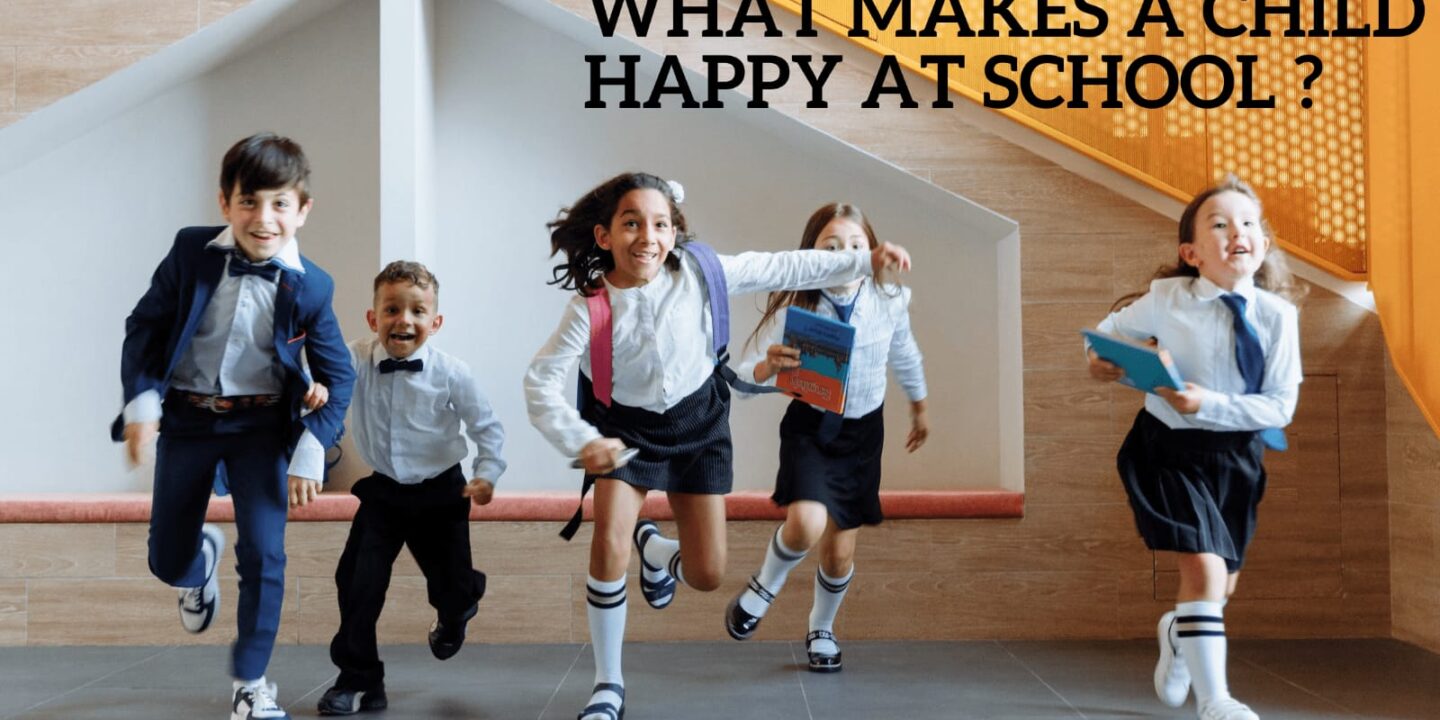
Remember those “I don’t wanna go” “My teacher is so grumpy” mornings, met with sleepy grumbles and the desperate desire to stay snuggled in bed? As a parent and former teacher, I know that feeling all too well. The question remained: “What makes a child happy at school?” But what if school wasn’t such a terrifying place, but a place where kids actually, truly flourished? Where learning felt like an adventure, and friendships blossomed like flowers?
Turns out, that’s not just a utopian dream. Research shows that happy kids learn better, and the good news is, that creating classrooms that spark joy and ignite curiosity isn’t as far-fetched as it seems. Let’s unravel the secrets of what makes kids tick in school, and maybe, just maybe, turn those “ughs” into enthusiastic “let’s go!”

A crucial element of happiness is connected to nature. Outdoor classes, nature walks, and interactive sessions can spark curiosity. Picture a science lesson under the shade of trees, turning learning into an adventure. This is a happiness booster! Connecting with nature reduces stress, improves focus, and fuels creativity. Textbooks pale in comparison to the thrill of discovery in the natural world.

A teacher’s kindness leaves a lasting impact. A smile, a helping hand—these simple gestures create a positive classroom atmosphere. It isn’t just about their knowledge – it is their warmth, passion, and genuine care for each student. Happy teachers create happy classrooms. They nurture curiosity, weave stories into lessons, celebrate individuality, and turn mistakes into stepping stones.
School isn’t just about academics; it’s about building lifelong bonds. Friendships make challenges easier and successes sweeter. When kids feel connected and valued, their happiness and well-being soar.
Bullying and embarrassing remarks can cast a dark cloud over even the most inspiring classrooms. Living in the midst of good warm relations is protective. Dr. Mona Delahooke, a best-selling author and a child psychologist, says that it’s not enough to say that we have a safe school. Safety is in the eye of the beholder. It’s in the child’s physiology that can be regulated with compassion and not just rules and regulations.
Traditional education suffocates creativity. Give kids a chance to make something out of nothing. Express themselves through, arts, crafts drama, and even coding. Turn classrooms into studios, workshops, and laboratories of invention. When kids are free to create their confidence blooms and happiness dances alongside their imagination.
In “If You Want to Be Rich & Happy Don’t Go to School”, Robert Kiyosaki emphasizes the importance of teaching not just academic subjects but also critical life skills to navigate the challenges of the real world. This contributes to a child’s sense of fulfillment and happiness in their educational journey.
In Susan Engel’s “The End of the Rainbow,” she argues that true learning flourishes in environments where collaboration and empathy take center stage. Imagine a math lesson where students solve problems not in isolation, but through teamwork, sharing strategies, and celebrating each other’s successes. This shift from individual achievement to collective learning fosters a sense of belonging and community, two crucial ingredients for happiness.
All kids are special and have different talents. Children want to be loved & respected for who they are. But standardized tests often make them feel like mismatched puzzle pieces. Let’s value diverse learning styles, encourage curiosity beyond textbooks, and acknowledge that intelligence comes in many forms

Children are naturally active, and schools should allow them to express their thoughts and feelings and to voice their opinions. This not only instills a sense of responsibility but also hones their leadership skills.
Clean surroundings and nutritious meals contribute to a happy and healthy school experience.
Interactive classes where students actively participate and understand concepts lead to a more engaging learning experience.
Learning through play is not just enjoyable but also enhances comprehension. Fun-filled activities keep the joy in learning alive.
Children find happiness in achieving something they are passionate about. Encouraging pursuits of their interests contribute to a sense of accomplishment.
Recognizing and appreciating efforts, not just grades, boosts a child’s self-esteem and motivation.
Providing opportunities for students to explore interests outside of academics and educational visits to the museum or pleasure trips to carnivals & amusement parks enhances their overall happiness.
Well-equipped and Modern Facilities contribute to a positive learning environment
Creating a culture of kindness and compassion within the school community contributes to a positive atmosphere where children experience the joy of making others happy.
The thrill of trying and mastering something new adds excitement to a child’s school experience, so they try their best
Encourage children to be grateful for the positive aspects of their lives. Many children can only dream of going to school but instead have to work hard to support their families and be involved in child labor.
Communication between parents and teachers is crucial. If a big change is happening in your home like a divorce or separation, a death, or a new baby then let the teacher know, so that she can give more love and care. This extra support will make your kids more secure.
Establishing regular study & healthy sleep habits contribute to a child’s overall happiness and well-being.
Help children focus on their strengths, past achievements, and acts of kindness, even during challenges. This fosters a positive outlook and resilience.

Parents and teachers should actively work on building a child’s self-esteem, emphasizing that failure is a natural part of the learning process. Some students in my class didn’t participate because they were afraid of failing. The kids didn’t tolerate failure. They would say ‘What if I’m wrong’. I always gave the example of Edison. Edison failed many times. But he used to say “I didn’t fail a thousand times. The light bulb was an invention with 1000 steps.”
We need to be a good listener. Actively listening to children’s concerns promotes trust and open communication.
Teaching children the importance of kindness, sharing, and playing fair creates a positive and harmonious school environment. This develops internal happiness naturally.
Turn fear of subjects into interest and passion through innovative teaching methods. This can positively impact a child’s attitude toward learning. I used to show interesting educational videos relevant to the topic to my children and students.
Encourage children to explore their interests and passions, developing a sense of purpose in their education.
Exposing children to positive content-enriching articles and books encourages a growth mindset.
Emphasize that not the number of friends but the quality of close relationships that matters. A worthy life is built with good relationships, not screen time, fame, or money.
In “Teaching Happiness in Schools,” Ian Morris emphasizes that true happiness for a child goes beyond academic success. Inner skills like mindfulness and emotional regulation fostered in the school environment, provide a foundation for genuine happiness and long-term well-being.
In “Winning the H Factor: The Secrets of Happy Schools” by Alistair Smith, Jones, and Reid, the authors underscore the importance of a positive school culture. Beyond effective teaching, cultivating emotional well-being and positive relationships among students, teachers, and parents creates an atmosphere essential for a child’s overall happiness and success in their educational journey.
Avoid excessive pressure and comparisons, focusing on each child’s unique journey.

Introduce meditation for mental well-being
In the tapestry of a child’s school experience, happiness weaves through nature’s playground, the warmth of loving teachers, the harmony of friendships, and the freedom to unleash creativity. It’s found in the safety of a supportive environment, the thrill of mastering something new, and the sense of fulfillment derived from both academic and life skills. The symphony of learning is complete when children are encouraged to express themselves, engage in teamwork, and pursue their passions. As parents, teachers, and schools, let’s build a positive mindset, actively listen to our children, and create environments that prioritize well-being over excessive academic pressure. By embracing these principles, we cultivate not just academic success but the essential elements that lead to a lifetime of joyous learning and fulfillment.